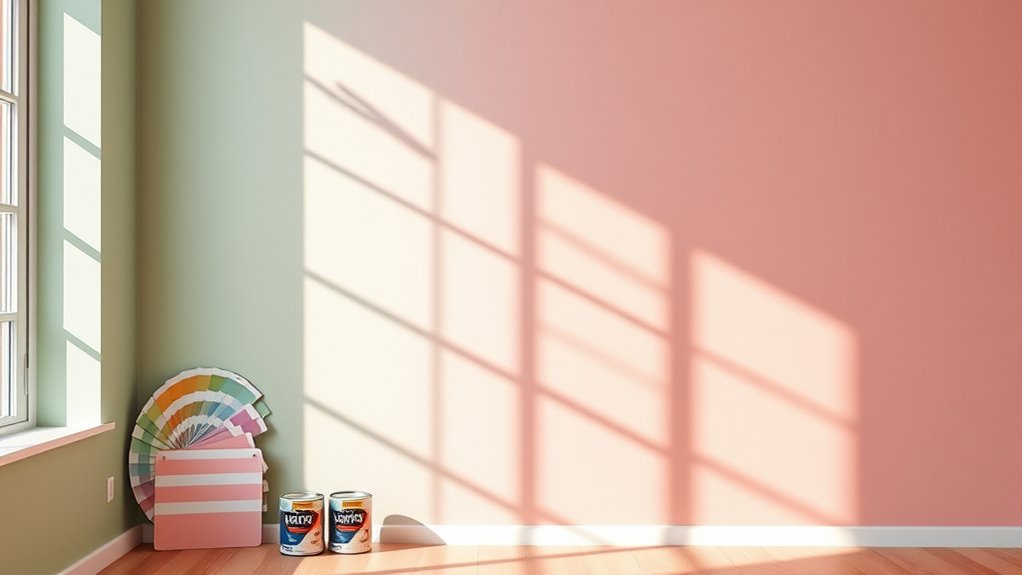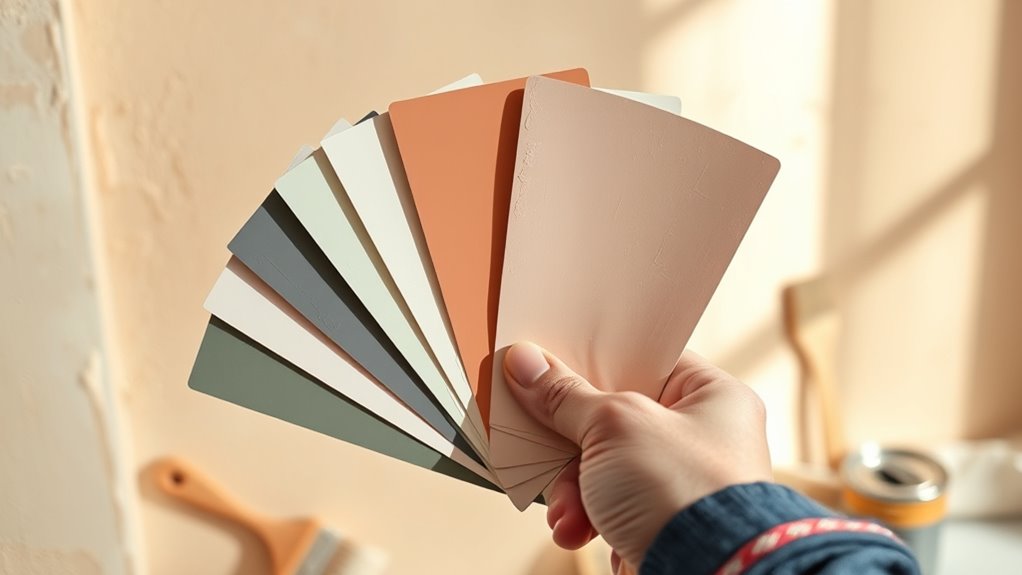To choose the right paint for your walls, consider the room’s function and your desired look. If you want to hide imperfections, go with flat or eggshell finishes; for durability and easy cleaning, opt for satin or semi-gloss. Water-based paints are eco-friendly and quick-drying, while oil-based paints offer a smooth, long-lasting finish. Pay attention to durability, environmental impact, and maintenance needs—your perfect choice will balance these factors. Keep exploring to find the ideal match.
Key Takeaways
- Determine wall surface needs and choose a finish (flat, eggshell, satin, semi-gloss, gloss) based on desired appearance and durability.
- Consider room function; high-moisture areas like kitchens and bathrooms benefit from moisture-resistant paints like satin or semi-gloss.
- Opt for water-based or latex paints for eco-friendliness, easy cleanup, and low VOC emissions, especially for indoor use.
- Match paint durability to traffic level; high-traffic areas need durable, washable finishes like semi-gloss or gloss.
- Balance aesthetic preferences with environmental impact, selecting low-VOC, eco-friendly options whenever possible.

Are you unsure how to choose the right paint for your project? Picking the perfect paint involves considering multiple factors, from the finish to durability and environmental impact. First, think about the look you want. Flat paint is great if you want to hide wall imperfections because it has no shine, but it’s less durable and might not withstand frequent cleaning. If you prefer a subtle sheen that’s easier to clean, eggshell paint offers a nice balance. For areas like kitchens and bathrooms where moisture and stains are common, satin paint provides a slight gloss that resists moisture, making it a practical choice. If you want a shiny, reflective surface, semi-gloss paint works well for trim and woodwork, adding a polished look and increased durability. For high-traffic zones or surfaces that need maximum durability, gloss paint is your best bet, especially for accents or furniture.
Next, consider the composition of the paint. Water-based paints are popular for interior walls because they dry quickly, emit fewer odors, and are easier to clean up with soap and water. Oil-based paints, on the other hand, produce a smooth, durable finish and are ideal for trim or surfaces that need extra resilience, but they take longer to dry and emit stronger fumes. Modified alkyd paints are tailored for trim and surfaces demanding extra toughness, combining some benefits of oil and water-based paints. Latex and acrylic paints are environmentally friendly options, flexible enough to prevent cracking and peeling while still offering good durability and aesthetic appeal. Your choice here depends on the specific needs of the surface and your environmental preferences.
Durability also guides your decision. If you need a finish that withstands wear and tear, opt for high-durability paints, often oil-based or modified alkyd. Flat finishes, while good at hiding imperfections, tend to be less durable and more prone to stains. Satin and semi-gloss paints strike a balance, offering decent durability and easier cleaning, ideal for busy areas. Gloss paints are extremely durable but can highlight surface imperfections, so they’re better suited for trim or surfaces that need frequent cleaning. For spaces prone to stains or messes, stain-resistant, water-based paints can make maintenance much easier.
Environmental impact matters too. Latex and water-based paints emit fewer volatile organic compounds (VOCs), making them safer for indoor air quality. They’re also easier to clean up, requiring just soap and water. Many regions regulate or restrict oil-based paints due to environmental concerns, so opting for eco-friendly, water-based options aligns with sustainability efforts. Brands now offer a wide range of eco-friendly paints, giving you choices that are both good for the environment and suitable for your aesthetic and functional needs.
Ultimately, your choice depends on your aesthetic preferences, the specific application, and how much maintenance you’re willing to do. Whether you want a matte finish to hide imperfections or a glossy, easy-to-clean surface, selecting the right paint type ensures your project looks great and lasts. Consider all these factors to make an informed decision that meets your needs and enhances your space.
Frequently Asked Questions
How Do I Determine the Best Finish for My Room?
To determine the best finish for your room, consider how much traffic and cleaning it needs. If you want a subtle look, go for flat or eggshell. For high-traffic or moisture-prone areas like kitchens or bathrooms, choose satin or semi-gloss. Think about imperfections and the ambiance you want—matte hides flaws, while shiny finishes reflect light and brighten the space. Match the finish to your needs for durability and aesthetic appeal.
What Environmentally Friendly Paint Options Are Available?
Imagine your walls as a canvas for change. Eco-friendly paints offer a greener path, made with natural ingredients, low VOCs, and certified safe. Brands like ECOS, Benjamin Moore Natura, and Sherwin-Williams Harmony provide options that reduce toxins, odors, and environmental impact. You get vibrant colors, healthier indoor air, and peace of mind, all while protecting the planet. Choosing these paints transforms your space into a sanctuary of sustainability.
How Does Paint Durability Affect Long-Term Costs?
Paint durability directly impacts your long-term costs by determining how often you’ll need to repaint. When you choose durable paint, it resists wear, fading, and damage longer, saving you money on frequent touch-ups or repaints. Cheaper paints might seem cost-effective initially but require more frequent maintenance, increasing expenses over time. Investing in high-quality, durable paint reduces your overall costs and keeps your walls looking better longer.
Can I Mix Different Paint Types in One Room?
Ever wonder if you can mix different paint types in one room? The truth is, you should prevent mixing oil-based and water-based paints—they won’t blend and can ruin your project. Stick to the same type, like latex with latex, and check that sheens are compatible. Always test your mixed paint on a small area first to ensure the color and finish turn out just right, saving you headaches later.
What Factors Influence Paint Drying Time and Application?
You should consider environmental factors like temperature, humidity, and ventilation, which all affect how quickly paint dries. Warmer, dry, and well-ventilated spaces speed up drying, while cold, humid conditions slow it down. The paint’s characteristics, such as type, sheen, and thickness, also matter. Additionally, surface porosity and preparation influence application and drying time. To get the best results, control these factors for faster, more even drying.
Conclusion
Now that you know how to select the right paint type, you’re ready to transform your walls with confidence. Choose the paint that matches your needs, consider the finish that suits your style, and prepare your space for a beautiful, lasting result. Embrace the process, enjoy the transformation, and take pride in your work. With the right paint, you’ll create a space that reflects your personality, enhances your home, and brings you joy every time you see it.










